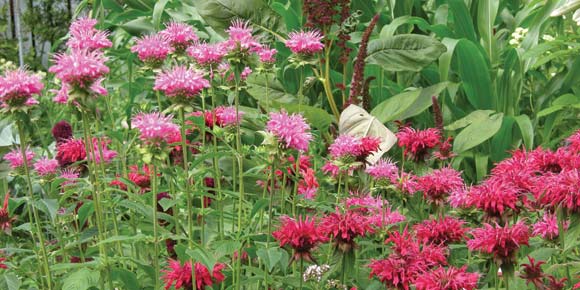Joe Pye weed
Joe Pye was an indigenous medicine man who shared his knowledge of a locally grown plant with early immigrants to Massachusetts to help deal with an epidemic of typhoid fever. The plant is botanically known as Eupatorium, but to the world at large, it is still known as Joe Pye weed. It has other common names including boneset for its ability to help folks suffering from fevers which can cause pain in the bones.
Whatever its medicinal reputation from the past, today it is a much admired ornamental that comes into its own at this time of year and will bloom until freeze up. It is a magnet for butterflies and bees as the flowerets of the purple umbels slowly open.
There are over 800 varieties in the species, offering everything from three feet tall to over eight feet, so be sure to check the tag when you buy so that you get the height and size right for your garden. It likes sunlight in a moist location to do its best. This large plant looks best when given pride of position in any garden.
Perennial phlox
Perennial phlox is a must-have in any August garden. It blooms for weeks and comes in a huge variety of colours from white to pink to magenta to purple to pink to salmon. It comes in bi-colours such as purple with magenta or white eyes. Look for Phlox paniculata rather than the creeping phlox which is low growing and blooms for a short period in springtime.
The flowers grow in panicles, clusters of small star-shaped blossoms, that can be fragrant.
Also called garden phlox, this is one of the easiest perennials to grow. It needs little tending and has few diseases or pests. Powdery mildew can be an issue, but give it a sunny spot in your garden and it will do its thing very happily, sending up 30-inch to 45-inch (some varieties will grow to five feet!) clumps of sturdy stocks that do not need staking. It’s another of those plants that are native to this country, one of the reasons for its being easy to grow.
The clumps will spread to as much as 40 inches wide, but seldom need dividing. If flower production slows, division may be warranted but I have had a white ‘David’ variety for more than 10 years and it is still happy. Those looking to increase their collection from division can begin doing so by the second year, but I would wait until the third year.
Bee balm (Monarda didyma)
Bee balm is one of those plants with fragrant leaves, and this is hardly surprising when you consider that it is part of the mint family. Another native to North America, it is a hardy and reliable bloomer beloved by bees and butterflies. It is also called bergamot for its scent which reminded American newcomers of bergamot orange from southern Italy and Northern Africa, used to scent Earl Grey tea.
There are both annual and perennials in the genus so be careful to look for the perennial, which blooms in later July early August.
The flowers are interesting, looking a bit like pin cushions with petals arranged in an upright manner from the tip of the stems. They come in white, pink, red and purple.
This is one plant that is particularly susceptible to powdery mildew. Plant monarda where there is plenty of air circulation to help prevent this. ‘Marshal’s Delight’, which was bred at the Morden Research Station, is mildew resitant.
The plant has antiseptic properties that were recognized by many of the eastern indigenous communities, who used it medicinally for everything from skin infections to teas to relieve stomach bronchial ailments. It was also used in cooking, mainly in flavouring for wild birds.
It grows in well-behaved clumps, two and a half to four feet tall, but there also some dwarf varieties.
Dorothy Dobbie is the publisher of Manitoba Gardner magazine. Listen to her weekly radio show on CJNU 93.7 FM on Sunday mornings. Call 204 -940-2700 to order a subscription.



